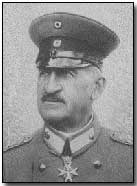Who's Who - Alexander von Linsingen
 Alexander von Linsingen (1850-1935)
served in active field commands on the Eastern Front for much of the First
World War.
Alexander von Linsingen (1850-1935)
served in active field commands on the Eastern Front for much of the First
World War.
Having joined the Prussian Army in 1868 Linsingen achieved divisional command in 1905 and corps command four years later, and partly owed his successful pre-war career to his mentor Erich Falkenhayn (who later succeeded Helmuth von Moltke as German Army Chief of Staff in September 1914).
The start of the First World War in August 1914 found Linsingen in command of II Corps attached to the German First Army. Within three months however he was transferred to serve with Hermann von Eichhorn's new Tenth Army where he was given command of the Austro-German Sudarmee in the Carpathians in January 1915, tasked with the forthcoming attack on Przemsyl.
Having impressed in the Carpathians Linsingen was next placed in charge of the Bug Offensive, replacing the formidable August von Mackensen in July 1915. Success there brought Linsingen further promotion to command of Army Group Linsingen, sent to occupy a critical area of southern Poland following the great Russian retreat. His Army Group consisted of the Bugarmee, the German Eleventh Army and (subsequently) the Austro-Hungarian Fourth Army.
Linsingen's fortunes took a turn for the worse however with the start of the Russian Brusilov Offensive in June 1916, which inflicted heavy damage upon the southern wing of the Austro-Hungarian element of his Army Group, although he subsequently partly retrieved the situation with German forces holding back the Russians further north.
With the Treaty of Brest-Litovsk ending the war on the Eastern Front in March 1918 Linsingen returned home to Germany. Promoted to full General and given command of the Berlin military region he viewed with dismay the onset of revolution in early November 1918. Realising he could do nothing to prevent revolution he resigned on 9 November, two days prior to the armistice.
He died in 1935.
A "lazy liz" was a heavy artillery shell fired by the Allied battleship Queen Elizabeth.
- Did you know?
